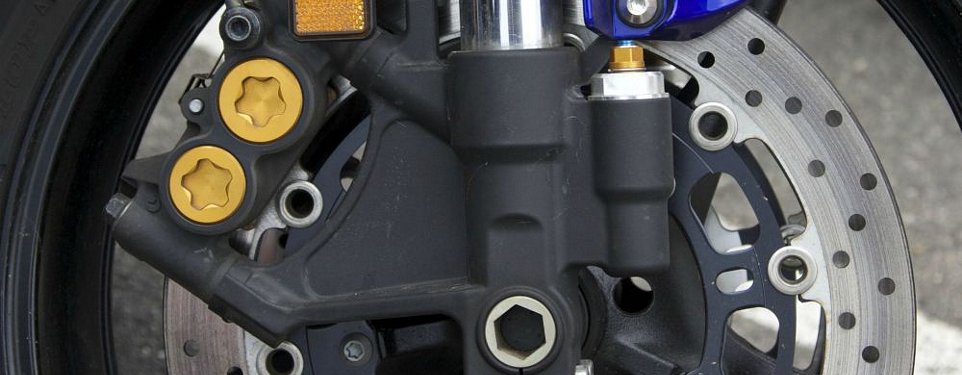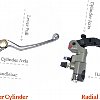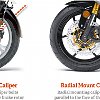Radial brakes seem to be all the rage among the sportbike crowd, right? Why are they in use? Let's "brake" it down!
When you hear someone talking about radial brakes, they may be talking about radial-mounted calipers or radial master cylinders. Let’s look at both, and discuss why they are gradually replacing their conventional counterparts on high-performance bikes.

Radial master cylinders
For as long as there have been juice brakes (hydraulic brake systems), there have been axial master cylinders. In an axial master setup, the master cylinder's bore runs perpendicular to the lever travel. A protrusion on the lever pushes the plunger in the cylinder to force fluid to the calipers, which squeeze the pads and make you stop. Axial master cylinders are still in use on all but the highest-performance bikes. How come? They work well and have been in use for decades. Why reinvent the wheel?
But this section is called radial master cylinders, so let's talk about those. Radial cylinders move the piston in the master cylinder in a direction parallel to the lever travel. That's it. That’s the big difference.
So in practical terms, what does a radial master cylinder get us? Quite simply, improved feel through parts with more rigidity. Rigidity is key to obtaining consistent, crisp braking feel. Many riders say a radial master gives more precise feel through the feedback the rider gets.
Many brake levers allow for lever position adjustment, but a few aftermarket units also allow adjustments in the linkage to give greater or lesser mechanical advantage to the lever. This allows fine tuning of the feel. Some riders, like Showroom Expert Bob, prefer a linear feel the whole way through the lever's travel. Others, like our Training Sensei Eric, prefer a big hit of stoppin’ juice right up front and then modulate that big dose of brakes after the initial bite.

Radial-mount brake calipers
When someone mentions "radial brakes," they’re usually talking about radial-mount calipers. For the longest time, calipers have been mounted to bosses that were cast into the lower fork tubes using bolts that run parallel with the axle. Radial calipers have similar bosses cast into the stanchions, but they are cast so that the caliper mounting bolts run perpendicular to the axle.
What does this mean? Well, as you can see in the illustration above, the braking forces transmitted are all in line with the direction of wheel rotation. There is no opportunity for deflection because the braking forces are on the exact same plane as the rotational forces.
There is no increase in braking power with a radial setup versus a conventional rig. Rather, the lack of torsional flexing (lateral movement) means crisper-feeling brakes at the lever. Although it may seem nearly imperceptible, that tenth of a millimeter or so that the calipers are allowed to deflect simply feels to the rider like a mushy brake lever.
The other benefit to these systems is that larger rotors can typically be fitted simply by spacing the caliper farther from its mounts. A traditional setup requires a custom mounting bracket, at a bare minimum, to make such a change. Larger rotors increase the mechanical advantage the caliper has on the rotor, which typically yields (you guessed it!) better braking feedback.
Why do we have this radial stuff?
These days, improvements in braking are subtle. The transition, say, from drum to disc brakes, or from cable to juice setups, was certainly noticeable to riders who experienced them, but we are reaching a point where improvements in sportbike braking are becoming sublime. Most bikes stop plenty fast for most riders, so the current focus is on making the brake system provide better feel for improved modulation.
Until recently, feel was really only altered through pad and rotor composition, rotor size, and brake line material. In the quest for superlative braking feedback, enterprising engineers began tweaking the moving parts of the hydraulic system.
Do we need all this just to come to a stop on a streetbike? Didn't axial master cylinders and traditional calipers do that just fine for years? Sure they did. But in the racing world, where maximum braking happens several times a lap and feel and feedback make the difference between victory and disaster, the tiny advantages of radial brakes add up. Since today's sportbikes reflect the technology honed in racing, you can find radial brakes right on your dealer's showroom floor.







